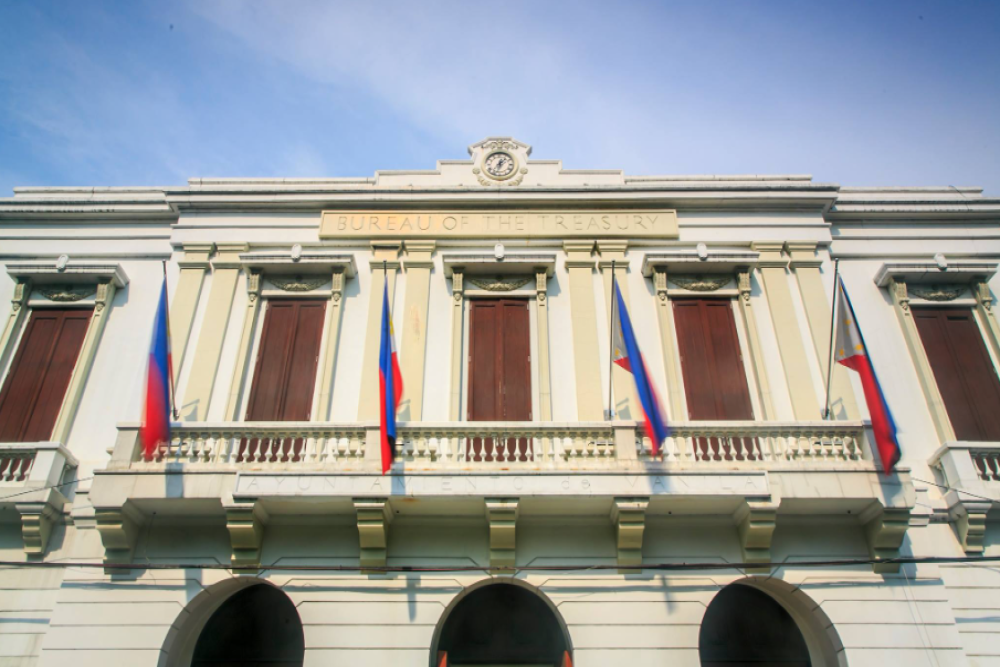The government’s Treasury bureau got a high level of success in its bond offerings at the beginning of this year, raising at least P154 billion.
As of the latest or on January 23, the Bureau of the Treasury (BTr) fully awarded the new 10-year Treasury bonds (T-bonds).
The auction received strong demand, as total submitted bids amounted to P102.2 billion.
The BTr raised the full program of P30 billion. The coupon rate was set at 6.25 percent, which is broadly in line with prevailing secondary market levels.
And in the prior day or on January 22, the BTr raised the planned P15 billion from its Treasury bills (T-bills) auction.
The auction was 2.3 times oversubscribed, attracting P35 billion in total tenders.
The 91-, 182-, and 364-day T-bills fetched average rates of 5.306 percent, 5.766 percent and 6.037 percent, respectively.
These were slightly higher than the 5.226 percent, 5.685 percent, and 5.999 percent average rate of the 91-, 182-, and 364-day T-bills on Jan. 15, 2024.
Rizal Commercial Banking Corporation chief economist Michael Ricafort said T-bills average auction yields corrected higher for the fifth straight auction.
"[This was] after reiteration over the weekend on hawkish signals by local monetary authorities in terms of keeping sufficiently tight monetary policy settings until there is a sustained downward trend in inflation despite the recent easing trend," Ricafort said, referring to the Bangko Sentral ng Pilipinas.
"Treasury bill auction yields continued to correct higher after some volatility in the US dollar/peso exchange rate recently to among 2.5-month highs, now at 56.30 levels," he added.
Earlier offerings
On January 16, the BTr fully awarded the new seven-year T-bonds, setting the coupon rate at 6.125 percent.
The auction received strong demand, going 3.6 times oversubscribed, as total submitted bids amounted to P107.1 billion.
The BTr raised the full program of P30 billion.
And on the prior day or on January 15, the BTr fully awarded bids for T-bills with a tenor of 91-, 182-, and 364-days fetching average rates of 5.226 percent, 5.685 percent, and 5.999 percent, respectively.
The auction attracted P43.2 billion in total tenders.
With its decision, the BTr raised the full program of P15 billion for the auction.
On January 9, the BTr fully awarded the new five-year T-bonds, setting the coupon rate at 6.125 percent.
The BTr said the auction was nearly 2.5 times oversubscribed as the total submitted bids amounted to P74.3 billion.
With its decision, the committee raised the full program of P30 billion.
On the prior day or on January 8, the BTr fully awarded bids for T-bills with a tenor of 91-, 182-, and 364-days that fetched average rates of 5.102 percent, 5.582 percent, and 5.973 percent, respectively.
The average rates of 182- and 364-day T-bills were slightly higher than last week's 5.582 percent and 5.973 percent.
The average rate of 91-day T-bills, however, slightly declined from last week's 5.140 percent.
The auction attracted P46.9 billion in total tenders, prompting the BTr auction committee to double the accepted volume of non-competitive bids for the 91- and 182-day T-bills.
With its decision, the BTr raised P19 billion compared to the P15 billion initial program.
Finally at the beginning of the year or on January 3, the BTr fully awarded the new three-year T-bonds, raising P30 billion.
The coupon rate was set at 6 percent.
The auction was 1.8 times oversubscribed as the total submitted bids amounted to P53.3 billion.
Ricafort said the average auction yield, which stood at 5.9 percent, was slightly lower than the comparable three-year PHP Bloomberg Valuation Service (BVAL) yield at 5.92 percent as of Jan. 2.
"Lower T-bond yield came after global crude oil prices at two-week lows and also among two-year lows that could help further ease headline inflation towards the central bank’s target and would also support possible policy rate cuts in 2024," Ricafort said.
He noted that the lower yield is also ahead of the expected easing of inflation in December 2023 and in the first quarter of 2024.
Retail trade bond issuance planned
Meanwhile, the government is eyeing the issuance of another retail treasury bond (RTB) as part of its efforts to raise the P2.46-trillion total financing requirement for this year.
The Department of Finance (DOF) said the BTr targets to issue the 30th tranche of its RTB within the first quarter of 2024.
"The RTBs encourage ordinary Filipinos to start investing in safe and stable sources of passive income, while promoting financial inclusion. To further this agenda, the BTr is looking to engage more digital finance platforms, allowing the BTr to reach a wider investor base," the DOF said.
The issuance of the RTB was one of the topics during a meeting held on January 17 at the BTr office in Intramuros, Manila convened by Finance Secretary Ralph Recto to discuss the country's 2024 financing program.
To raise the country’s total financing requirement of P2.46 trillion for this year, the government will continue to adopt a 75:25 borrowing mix in favor of domestic sources.
"This prudent debt management strategy will allow the country to effectively mitigate foreign exchange risks, take advantage of the abundant liquidity in the country’s financial system, and support the development of the local debt and capital markets," the DOF added.
To further develop the country’s local debt and capital markets, the BTr will spearhead several capital market development initiatives such as improving the Government Securities Repurchase Agreement (Repo) Program and inclusion in an emerging market bond index.
To fulfill its 2024 external financing program, the BTr is looking at various global bond markets, consistent with its objective of diversifying funding sources.
The BTr is also exploring a potential curtain-raiser offering in the first semester of the year.
Last year, the BTr raised P1.87 trillion despite the challenging market environment.
Of the total, P1.65 trillion was sourced from the issuance of domestic treasury bills and government securities, while another P220 billion from external commercial sources.


